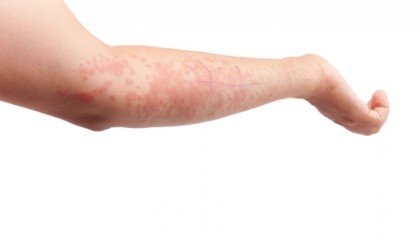The anti-epileptic medication Lamictal has a known tendency to cause a serious rash, especially when used in combination with other epilepsy drugs. This rash may be the first sign of Stevens Johnson Syndrome (SJS).
Lamictal, also known by its generic name lamotrigine, is an anti-convulsant medication approved by the FDA as a treatment for epileptic seizures in adults and children. This drug is used either by itself or concurrently with other drugs. It’s also approved as a means of delaying mood episodes in adults with bipolar disorder.
Lamictal side effects, though not necessarily common, can lead to serious medical problems. One of the more common Lamictal side effects is a skin rash. The likelihood of rash increases when Lamictal is taken in combination with other antiseizure drugs, such as valproate, carbamazepine or clonazepam. In clinical studies, about 10 percent of patients who added Lamictal to an existing anti-epileptic medication regimen reported developing a rash.
Where the patient is particularly hypersensitive to Lamictal, this rash can be severe enough to require hospitalization. In clinical trials, some patients showed other symptoms of hypersensitivity in addition to rash, such as multi-organ failure. Some cases of Lamictal rash were severe enough to be life-threatening and a few rare deaths have been reported.
Lamictal Stevens Johnson Syndrome
Though potentially life-threatening by itself, a Lamictal rash may be the beginning of two even more dangerous conditions: Stevens Johnson Syndrome (SJS) and Toxic Epidermal Necrolysis (TEN).
A rash is one of the more common first signs of Stevens Johnson Syndrome. Other initial symptoms resemble those of the flu, such as body aches, headache, fever, or cough. As the condition progresses, the rash can develop into blisters that enlarge and coalesce into large areas of skin that may begin to peel away. The amount of skin area covered by these lesions is the main difference between SJS and TEN; where these areas cover 30 percent or more of the body, the condition is then referred to as TEN.
The loss of skin from SJS can lead to multiple other complications, such as skin or blood infections, that can result in sepsis. Eye symptoms such as inflammation and excessive purulence may occur. Damage to internal organs may also happen in rare cases.
Recovery from Lamictal SJS requires hospitalization. Due to the similarity of SJS and TEN to severe burns, similar treatments are used. Any medication that caused the condition must be discontinued. Treatment then focuses on addressing symptoms for as long as it takes the body to heal itself. The patient may be in hospital for weeks or months, receiving regular changes of dressing for the affected skin areas.
Most cases of SJS and TEN are drug-related. Once a patient has a known history of SJS or TEN related to a certain drug, they must avoid using that drug again. Other risk factors for SJS are viral infections, a compromised immune system such as with HIV/AIDS, or a family history of SJS. Persons with a certain gene called HLA-B 1502, typically found in persons of Chinese, Indian, or Southeast Asian descent, are also at greater risk for SJS.
Do YOU have a legal claim? Fill out the form on this page now for a free, immediate, and confidential case evaluation. The Stevens Johnson Syndrome attorneys who work with Top Class Actions will contact you if you qualify to let you know if an individual lawsuit or class action lawsuit is best for you. [In general, SJS lawsuits are filed individually by each plaintiff and are not class actions.] Hurry — statutes of limitations may apply.
ATTORNEY ADVERTISING
Top Class Actions is a Proud Member of the American Bar Association
LEGAL INFORMATION IS NOT LEGAL ADVICE
Top Class Actions Legal Statement
©2008 – 2025 Top Class Actions® LLC
Various Trademarks held by their respective owners
This website is not intended for viewing or usage by European Union citizens.
Get Help – It’s Free
Help for Victims of Stevens Johnson Syndrome
If you or a loved one were diagnosed with Stevens Johnson Syndrome (SJS) or toxic epidermal necrolysis (TEN) after taking a prescribed or over-the-counter medication, you may be eligible to take legal action against the drug’s manufacturer. Filing an SJS lawsuit or class action lawsuit may help you obtain compensation for medical bills, pain and suffering, and other damages. Obtain a free and confidential review of your case by filling out the form below.
An attorney will contact you if you qualify to discuss the details of your potential case at no charge to you.
Oops! We could not locate your form.













